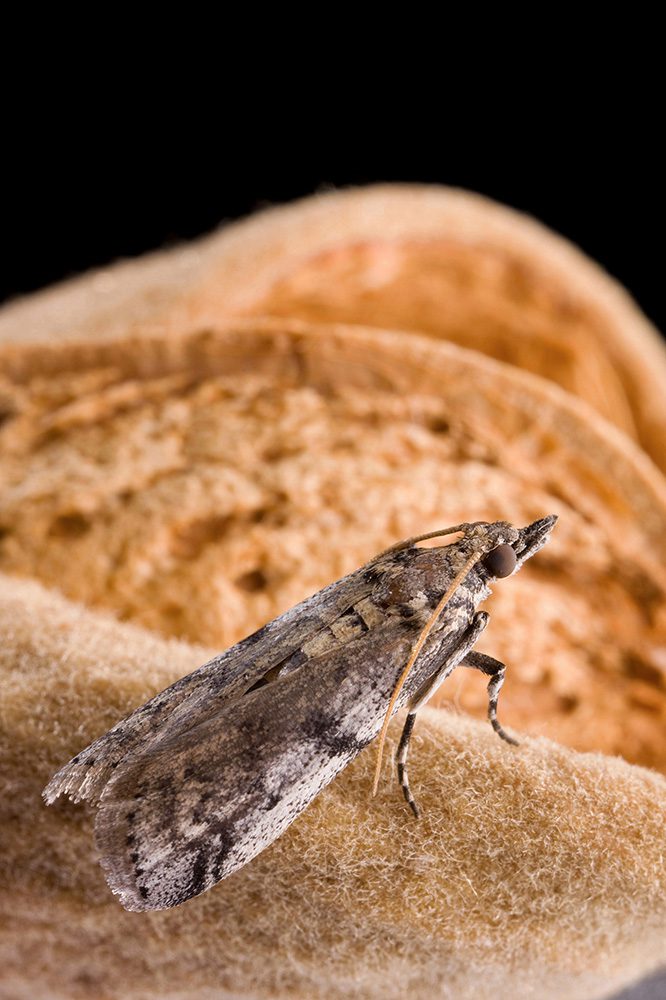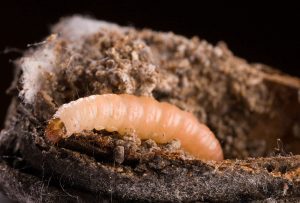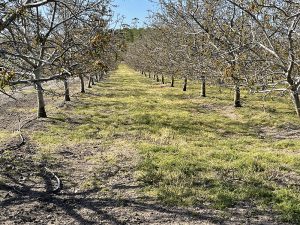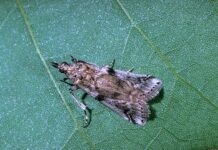
Navel orangeworm (NOW) is known to be one of the most important insect pests of almonds and pistachios, but it’s also one of several key pests for walnuts. Its degree of importance in walnuts often depends on when and where an orchard is located, according to Chuck Burks, a research entomologist with USDA, who has been studying NOW since 2000.
Much of Burks’ work has focused on monitoring and mating disruption and has helped to develop and define some of the mating disruption systems used today. Recently, he has been trying to improve the ability to predict when and where NOW is going to be problematic for walnuts.
Unfortunately, foretelling NOW’s next move is anything but exact. Burks said monitoring research for NOW continues to take place in part because predictions of the pest have always been difficult and continue to be difficult.
“Our crystal balls don’t work that well,” he said.
The pest has a very strong reproductive capacity as well as a strong ability to disperse, Burks explained, particularly to neighboring or adjacent orchards.
“It has a wide host range, but it does particularly well on the tree nuts,” he said.
As the tree nut industry has grown substantially and various tree nut crops move closer to one another, it has expanded the ability of NOW to take advantage of the earlier harvest varieties of almonds before jumping over to pistachios and walnuts.
“Because of the acreage expansion, they are more likely to be in the vicinity,” Burks said.
NOW affects other crops like figs and pomegranates, but its economic impact is mostly felt by the nut industry. It seems to do particularly well on earlier-bearing varieties, while Chandler, which has seen the greatest acreage expansion in recent decades, fares the best.
“Chandler is the least susceptible walnut variety since it’s the latest harvested,” Burks said. “But NOW can still cause problems for Chandler, particularly if it is in the vicinity of other nut crops.”
NOW is a pest that can have a potentially explosive growth and can get severely out of hand, according to Burks, who recalls seeing damage above the 20% range in some locations in the past. Those cases, he noted, are typically due to a combination of factors, such as a wet spring, or a lack of labor when sanitation isn’t able to happen as efficiently, or even a later-generation moth coming in ahead of the split on one of the crops.
“It can lead to some pretty heavy economic loss if people get caught off guard,” he said.
The damage from NOW on walnut crops won’t often be very apparent, since the pest is an internal feeder and requires some type of an entry point.
While walnuts aren’t inherently susceptible to NOW prior to husk split, late into August and into September, depending on the variety and the year, diseases like walnut blight, sunburn or codling moth can cause the nuts to become susceptible to NOW earlier.
The degree of NOW’s abundance has historically been related to the amount of heat units an area receives during the summer, Burks explained. That means regions like the Southern San Joaquin Valley will see more generations than places like the Northern Sacramento Valley or the cooler Delta regions. Although he said that doesn’t mean those areas will be free from NOW, particularly as nut crops are planted more closely together.
“Of course, if you get a situation where there’s a more general warming over the entire area, that will drive more generations,” he said.

NOW Treatment Options
Ways to treat for NOW in nut crops typically include mating disruption or pesticides. Burks said mating disruption is a very good option for pistachio and almond but might not always be the way to go for walnuts.
Mating disruption is most successful when taken as an area wide approach, and since it’s not easy to tell if a situation is coming from within your own orchard, versus if it’s coming from a crop outside your orchard, it makes mating disruption a bit more difficult, he explained.
“Because mating disruption is a birth control method, if your problem is coming from within your orchard, it might be valuable,” Burks said. “But if your problem is coming from other orchards, or other crops in particular, then mating disruption is less likely to be valuable.”
That’s because moths coming in from outside an orchard are likely to have already been mated before they move in.
“Since mating disruption is preventing mating, if mated moths come in, then it really does not have any effect on them,” Burks said.
Other treatment options for NOW in walnuts include husk split insecticides, and recent research funded by the California Walnut Board has aimed to use monitoring to recognize when those treatments are useful and when they are not needed by determining if moths are coming in from the outside.

“That’s work we did over several years with different monitoring approaches,” Burks said.
In terms of treatment challenges over the next period of years, Burks said insecticides for NOW treatment are going to be more constrained, with growers being pushed into a situation where they will be more dependent on materials with low, non-target effects.
“So, things like mating disruption, cultural control, other biorational techniques and area-wide approaches will become more important with time,” he said.
Mating Disruption Study in Walnuts
A current UC study that began in late spring and will conclude at harvest is examining mating disruption in six walnut orchards in two regions; three in the Northern San Joaquin Valley and three in the Sacramento Valley.
The trial is comparing between minimum 40-acre blocks, each with mating disruption and without, keeping other factors the same for both blocks, explained Dr. Jhalendra Rijal, UCCE IPM advisor for the northern San Joaquin Valley. The study is being conducted in collaboration with the California Walnut Board and the private industry.
Rijal said the trial includes orchards with both high and low NOW pressure, with the goal being to compare different scenarios.
“So far, we’ve seen the pheromone “trap shutdown” which you would expect from mating disruption as it hinders male moths’ ability to find females for mating, and we’re getting that on these different blocks,” he said. “So, we’re happy with the performance so far, but the ultimate performance would be to evaluate the nut damage between these two plots, and that would be at harvest time.”
Outside of the study, Rijal said he’s not seeing any major trends of note with NOW right now except the second flight began later than the previous years, and this is true for other major insect pests up and down the valley this year due to the exceptionally cooler spring and early summer. But Rijal emphasizes every orchard is different, and NOW prevalence can vary from orchard to orchard.
“Some orchards, when they have a history of damage, or other NOW host crops nearby, those orchards likely get more damage than the others,” he said.
Rijal said growers will need to be cognizant of NOW’s third and fourth flights; after husk split, trees are vulnerable.
“Third generations, which start around early to mid-August or so, depending on where you are at in the Valley, the tail end of that flight can affect some of the walnuts, specifically the early varieties,” he said.
That will be the key window if a grower decides to spray for NOW for those varieties if the cost/benefit makes sense. This year is very difficult to do even minimum orchard maintenance or management for walnut growers because of the historically low walnut price, Rijal said.
If a grower considers spraying as an option for treatment and decides the input costs are justified as a loss minimization effort, there are some important things to consider before choosing an insecticide. Of the most standard insecticides used to treat NOW on nut crops like almonds, pistachios and walnuts, there are two groups to consider: The first, reduced-risk and primarily larvicidal insecticides such as methoxyfenozide and chlorantraniliprole. They are the most effective as they won’t have much impact on natural enemies or beneficial predators. The second, broad-spectrum, pyrethroids or other combo products, can be relatively cheaper but come with the side effect of potentially killing beneficial insects. For organic orchards, based on the last few years’ trials in almonds, spinosad, pyrethrin, a few Bt- and neem-based products are efficacious.
The bottom line for NOW management is to reduce the overwintering population by performing winter sanitation and reducing the predisposing factors such as codling moth-infested and blighted nuts during the season. These practices, along with seasonal monitoring, are important for keeping the NOW population build up in the orchard.
“So, although Chandler is the least susceptible variety, occasionally we have seen NOW causing economic damage in this variety as well late in the season,” Rijal said. “If there is need for an insecticide in these challenging orchards, these are two groups that can be applied.”











